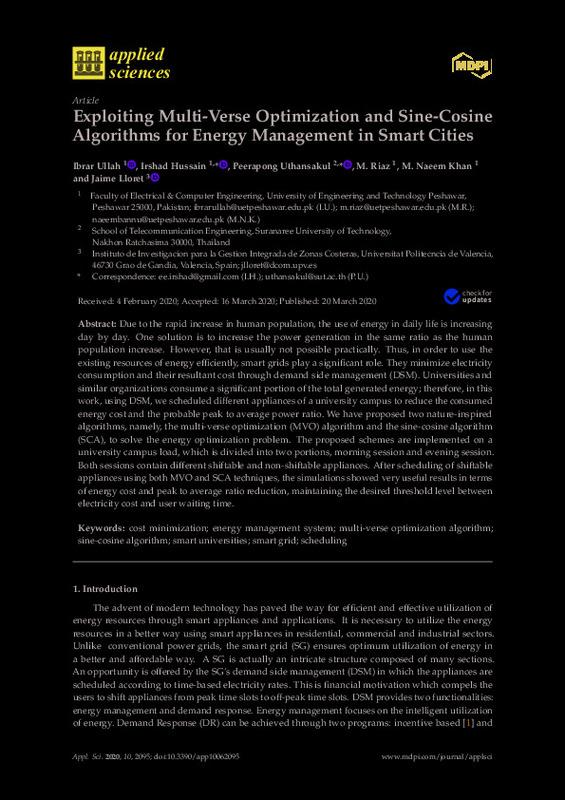JavaScript is disabled for your browser. Some features of this site may not work without it.
Buscar en RiuNet
Listar
Mi cuenta
Estadísticas
Ayuda RiuNet
Admin. UPV
Exploiting multi-verse optimization and sine-cosine algorithms for energy management in smart cities
Mostrar el registro sencillo del ítem
Ficheros en el ítem
| dc.contributor.author | Ullah, Brar
|
es_ES |
| dc.contributor.author | Hussain, Irshad
|
es_ES |
| dc.contributor.author | Uthansakul, Peerapong
|
es_ES |
| dc.contributor.author | Riaz, M.
|
es_ES |
| dc.contributor.author | Khan, M. Naeem
|
es_ES |
| dc.contributor.author | Lloret, Jaime
|
es_ES |
| dc.date.accessioned | 2022-11-07T16:34:25Z | |
| dc.date.available | 2022-11-07T16:34:25Z | |
| dc.date.issued | 2020-03-20 | es_ES |
| dc.identifier.uri | http://hdl.handle.net/10251/189347 | |
| dc.description.abstract | [EN] Due to the rapid increase in human population, the use of energy in daily life is increasing day by day. One solution is to increase the power generation in the same ratio as the human population increase. However, that is usually not possible practically. Thus, in order to use the existing resources of energy efficiently, smart grids play a significant role. They minimize electricity consumption and their resultant cost through demand side management (DSM). Universities and similar organizations consume a significant portion of the total generated energy; therefore, in this work, using DSM, we scheduled different appliances of a university campus to reduce the consumed energy cost and the probable peak to average power ratio. We have proposed two nature-inspired algorithms, namely, the multi-verse optimization (MVO) algorithm and the sine-cosine algorithm (SCA), to solve the energy optimization problem. The proposed schemes are implemented on a university campus load, which is divided into two portions, morning session and evening session. Both sessions contain different shiftable and non-shiftable appliances. After scheduling of shiftable appliances using both MVO and SCA techniques, the simulations showed very useful results in terms of energy cost and peak to average ratio reduction, maintaining the desired threshold level between electricity cost and user waiting time | es_ES |
| dc.language | Inglés | es_ES |
| dc.publisher | MDPI AG | es_ES |
| dc.relation.ispartof | Applied Sciences | es_ES |
| dc.rights | Reconocimiento (by) | es_ES |
| dc.subject | Cost minimization | es_ES |
| dc.subject | Energy management system | es_ES |
| dc.subject | Multi-verse optimization algorithm | es_ES |
| dc.subject | Sine-cosine algorithm | es_ES |
| dc.subject | Smart universities | es_ES |
| dc.subject | Smart grid | es_ES |
| dc.subject | Scheduling | es_ES |
| dc.title | Exploiting multi-verse optimization and sine-cosine algorithms for energy management in smart cities | es_ES |
| dc.type | Artículo | es_ES |
| dc.identifier.doi | 10.3390/app10062095 | es_ES |
| dc.rights.accessRights | Abierto | es_ES |
| dc.description.bibliographicCitation | Ullah, B.; Hussain, I.; Uthansakul, P.; Riaz, M.; Khan, MN.; Lloret, J. (2020). Exploiting multi-verse optimization and sine-cosine algorithms for energy management in smart cities. Applied Sciences. 10(6):1-21. https://doi.org/10.3390/app10062095 | es_ES |
| dc.description.accrualMethod | S | es_ES |
| dc.relation.publisherversion | https://doi.org/10.3390/app10062095 | es_ES |
| dc.description.upvformatpinicio | 1 | es_ES |
| dc.description.upvformatpfin | 21 | es_ES |
| dc.type.version | info:eu-repo/semantics/publishedVersion | es_ES |
| dc.description.volume | 10 | es_ES |
| dc.description.issue | 6 | es_ES |
| dc.identifier.eissn | 2076-3417 | es_ES |
| dc.relation.pasarela | S\473142 | es_ES |








